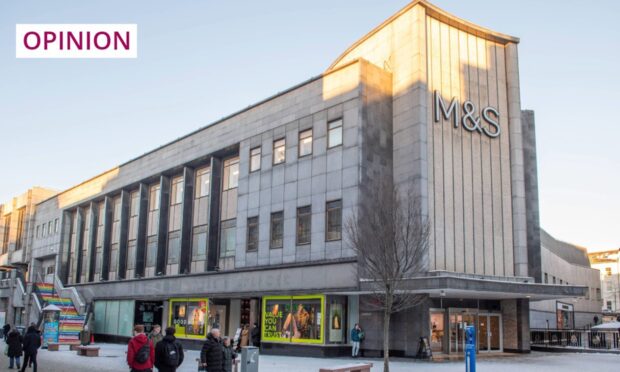Whatever your view, the closure of Marks and Spencer on Aberdeen’s St Nicholas Street after 80 years will prompt the end of an era.
In recent years, many department stores have shut their doors for the final time across the Granite City’s once bustling centre. As a result, the large buildings they once occupied now lie empty: too big for other retailers to move into, and too costly or complicated to convert for other uses.
There is an understandable fear locally that the flagship M&S shop, located at the heart of the city, is destined for the same fate as the now deserted former John Lewis building, just a stone’s throw away. An important difference is Marks and Spencer’s apparently measured handling of the situation, in comparison to John Lewis’s cut-and-run approach.
 M&S plans to stay in Aberdeen and expand its shop at Union Square, pledging to keep all current St Nicholas Street staff employed. Furthermore, the flagship branch will not close until 2025, letting workers, customers and other businesses adapt to the change.
M&S plans to stay in Aberdeen and expand its shop at Union Square, pledging to keep all current St Nicholas Street staff employed. Furthermore, the flagship branch will not close until 2025, letting workers, customers and other businesses adapt to the change.
Already, First Bus has confirmed it will monitor demand for services stopping at Union Square, to ensure members of the public can still easily visit M&S if they wish to. This may bring comfort to shoppers with mobility issues who currently frequent and rely on the St Nicholas Street branch.
Though Marks and Spencer is by no means bidding Aberdeen farewell, its announcement only further highlights how much the high street as a whole has changed. And, despite frequent discussions, it seems we are no closer to defining what high streets, city and town centres of the future could and should look like, not just in Aberdeen but in Scotland and the UK.
What does the high street of the future look like?
Working with the council and Our Union Street, M&S says it is committed to finding a new use for the vast St Nicholas Street site. After eight decades of loyal custom from Aberdonian shoppers, it is encouraging to see the company taking responsibility for the evolution of its former home.
Some argue transforming empty retail and office spaces into flats could help Scotland’s housing crisis and automatically reinvigorate cities by bringing people back from the outskirts.
However, nobody wants to live in a ghost town; a mix of housing, hospitality and retail is surely still vital to a thriving centre.
Eyewatering business rates mean firms are struggling to survive, with increasingly urgent calls for government relief. There is a delicate balance to be struck, and a great deal of figuring out still left to be done. It is cheering to see Marks and Spencer engaging with that conversation rather than riding off into the sunset.
The Voice of the North is The Press & Journal’s editorial stance on what we think are the most important issues of the week



Conversation